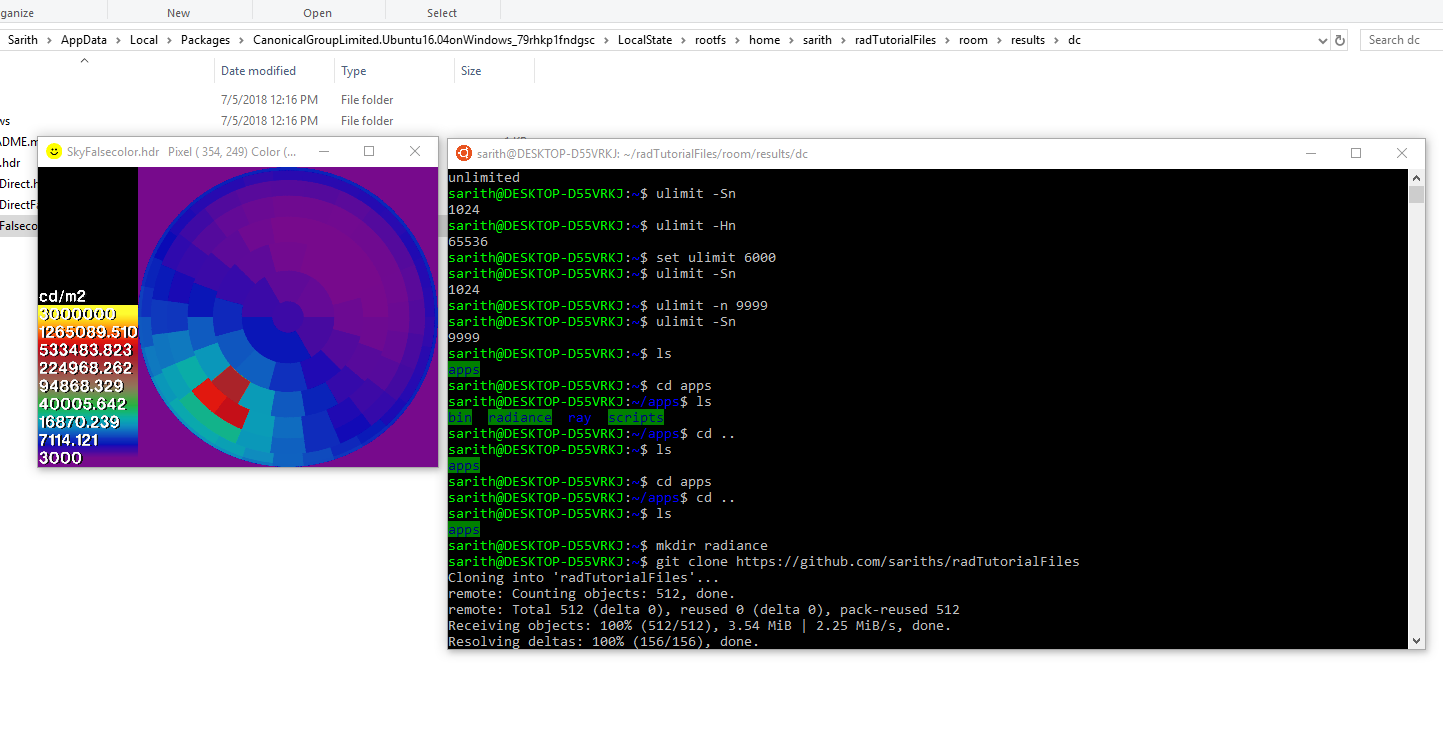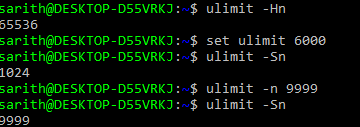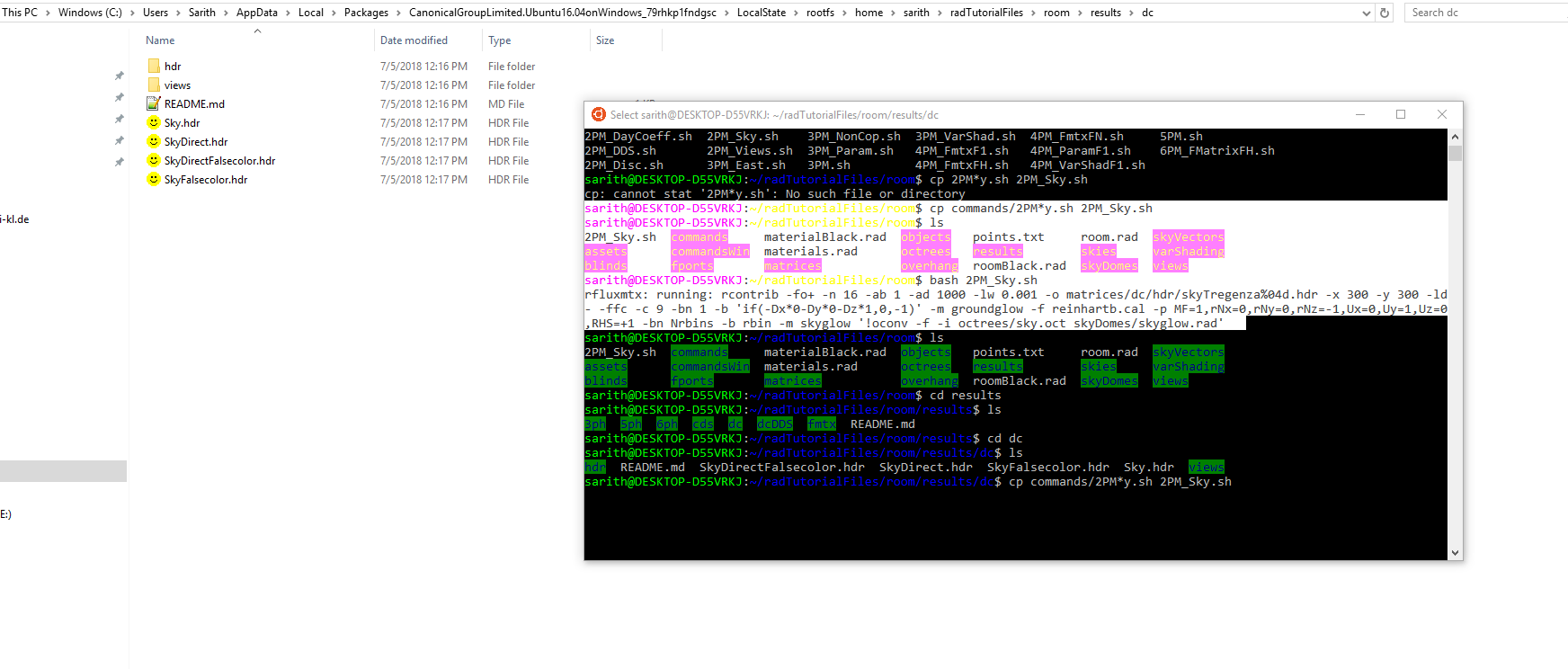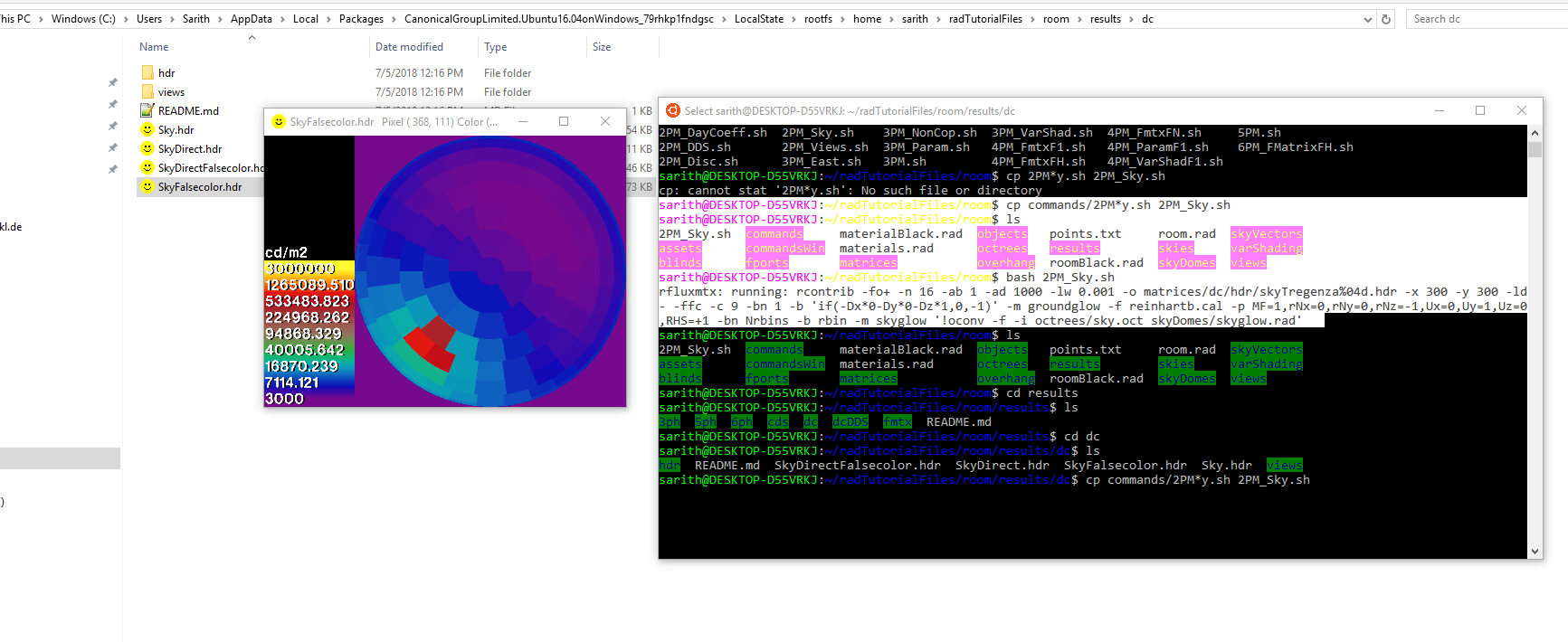First time here? Check out the Help page!
 | 1 | initial version |
I was surprised that this works, but the Ubuntu 16.04 available as a free download through the Windows 10 app store actually manages to run Radiance commands (including the ones in the tutorial). Below is a screenshot of the Sky coefficients example from the tutorial (https://github.com/sariths/radTutorialFiles/blob/master/room/commands/2PM_Sky.sh).

Based on the terminal commands alone, it seems that you can increase the number of file descriptors (I did not test this on a simulation).

I built Radiance from source and found that some of the binaries that compile normally on a standard Ubuntu machine did not compile on the Windows version.
If you absolutely have to run the Five-Phase Method with 5000+ suns on a Windows OS, you can tweak the rcontrib command to work with modifier-lists instead of the multiplying factor and cal file. This ....
vwrays -vf views/eastBlinds.vf -x 400 -y 400 -pj 0.7 -ff | rcontrib -w- -i -ab 1 -ad 256 -lw 1.0e-3 -dc 1 -dt 0 -dj 0 -ffc -n 16 `vwrays -vf views/eastBlinds.vf -x 400 -y 400 -d` -o matrices/cds/hdrIllSpace/eastBlindsM6%04d.hdr -e MF:6 -f reinhart.cal -b rbin -bn Nrbins -m solar octrees/sunCoefficients.oct
..will be replaced by something like...
vwrays -vf views/eastBlinds.vf -x 400 -y 400 -pj 0.7 -ff | \
rcontrib -w- -i -ab 1 -ad 256 -lw 1.0e-3 -dc 1 -dt 0 -dj 0 -ffc -n 16 `vwrays -vf views/eastBlinds.vf -x 400 -y 400 -d` -o matrices/cds/hdrIllSpace/eastBlindsM6%04d.hdr -M solar_modifier_list_r6.txt octrees/sunCoefficients.oct
That way you can run the calculation with 512 or 1024 suns at a time and then renumber the files in the way dctimestep expects them to be. There are several intermediate steps that need to be tweaked to make this work, and the end result will likely be inefficient compared to the current one. The most obvious bottleneck being that even if you make this work, you'd still be running rcontrib on a single thread. Conversely if you run multiple instances of rcontrib on different threads (through Python Perl, Ruby etc), you'd still be only able to open 512 or 1024 files at a time.
This..
I was thinking that rather than use rcontrib, I could I produce the direct sun component (CdsSun) for the 5 phases separately using rpict. I could write a python script that renders the suns direct contribution for 8760 hours of the year then continue the standard 5 phase methodology. My first thoughts are that (providing the script cleans up after itself) this feasible and would take a similar amount of time. I can make sun only perez skies via genskymtx. Am I being naive here?
..might be worth testing. You'd have to parse through the 8760 hours in the wea file first and pass on the location details and direct normal radiation values to create an rpict image for each hour (that also means generating an octree for each one of those images with an existing octree and new sky file). I havent thought this through completely, but it seems somewhat feasible.
Instead of going through all of the above, a simple solution, if you want to work through your existing Windows installation, is to run Radiance on a linux virtual machine.
 | 2 | No.2 Revision |
I was surprised that this works, but the Ubuntu 16.04 available as a free download through the Windows 10 app store actually manages to run Radiance commands (including the ones in the tutorial). Below is a screenshot of the Sky coefficients example from the tutorial (https://github.com/sariths/radTutorialFiles/blob/master/room/commands/2PM_Sky.sh).


Based on the terminal commands alone, it seems that you can increase the number of file descriptors (I did not test this on a simulation).

I built Radiance from source and found that some of the binaries that compile normally on a standard Ubuntu machine did not compile on the Windows version.
If you absolutely have to run the Five-Phase Method with 5000+ suns on a Windows OS, you can tweak the rcontrib command to work with modifier-lists instead of the multiplying factor and cal file. This ....
vwrays -vf views/eastBlinds.vf -x 400 -y 400 -pj 0.7 -ff | rcontrib -w- -i -ab 1 -ad 256 -lw 1.0e-3 -dc 1 -dt 0 -dj 0 -ffc -n 16 `vwrays -vf views/eastBlinds.vf -x 400 -y 400 -d` -o matrices/cds/hdrIllSpace/eastBlindsM6%04d.hdr -e MF:6 -f reinhart.cal -b rbin -bn Nrbins -m solar octrees/sunCoefficients.oct
..will be replaced by something like...
vwrays -vf views/eastBlinds.vf -x 400 -y 400 -pj 0.7 -ff | \
rcontrib -w- -i -ab 1 -ad 256 -lw 1.0e-3 -dc 1 -dt 0 -dj 0 -ffc -n 16 `vwrays -vf views/eastBlinds.vf -x 400 -y 400 -d` -o matrices/cds/hdrIllSpace/eastBlindsM6%04d.hdr -M solar_modifier_list_r6.txt octrees/sunCoefficients.oct
That way you can run the calculation with 512 or 1024 suns at a time and then renumber the files in the way dctimestep expects them to be. There are several intermediate steps that need to be tweaked to make this work, and the end result will likely be inefficient compared to the current one. The most obvious bottleneck being that even if you make this work, you'd still be running rcontrib on a single thread. Conversely if you run multiple instances of rcontrib on different threads (through Python Perl, Ruby etc), you'd still be only able to open 512 or 1024 files at a time.
This..
I was thinking that rather than use rcontrib, I could I produce the direct sun component (CdsSun) for the 5 phases separately using rpict. I could write a python script that renders the suns direct contribution for 8760 hours of the year then continue the standard 5 phase methodology. My first thoughts are that (providing the script cleans up after itself) this feasible and would take a similar amount of time. I can make sun only perez skies via genskymtx. Am I being naive here?
..might be worth testing. You'd have to parse through the 8760 hours in the wea file first and pass on the location details and direct normal radiation values to create an rpict image for each hour (that also means generating an octree for each one of those images with an existing octree and new sky file). I havent thought this through completely, but it seems somewhat feasible.
Instead of going through all of the above, a simple solution, if you want to work through your existing Windows installation, is to run Radiance on a linux virtual machine.
 | 3 | No.3 Revision |
I was surprised that this works, but the Ubuntu 16.04 available as a free download through the Windows 10 app store actually manages to run Radiance commands (including the ones in the tutorial). Below is a screenshot of the Sky coefficients example from the tutorial (https://github.com/sariths/radTutorialFiles/blob/master/room/commands/2PM_Sky.sh).

 Based on the terminal commands alone, it seems that you can increase the number of file descriptors (I did not test this on a simulation).
Based on the terminal commands alone, it seems that you can increase the number of file descriptors (I did not test this on a simulation).

I built Radiance from source and found that some of the binaries that compile normally on a standard Ubuntu machine did not compile on the Windows version.
If you absolutely have to run the Five-Phase Method with 5000+ suns on a Windows OS, you can tweak the rcontrib command to work with modifier-lists instead of the multiplying factor and cal file. This ....
vwrays -vf views/eastBlinds.vf -x 400 -y 400 -pj 0.7 -ff | rcontrib -w- -i -ab 1 -ad 256 -lw 1.0e-3 -dc 1 -dt 0 -dj 0 -ffc -n 16 `vwrays -vf views/eastBlinds.vf -x 400 -y 400 -d` -o matrices/cds/hdrIllSpace/eastBlindsM6%04d.hdr -e MF:6 -f reinhart.cal -b rbin -bn Nrbins -m solar octrees/sunCoefficients.oct
..will be replaced by something like...
vwrays -vf views/eastBlinds.vf -x 400 -y 400 -pj 0.7 -ff | \
rcontrib -w- -i -ab 1 -ad 256 -lw 1.0e-3 -dc 1 -dt 0 -dj 0 -ffc -n 16 `vwrays -vf views/eastBlinds.vf -x 400 -y 400 -d` -o matrices/cds/hdrIllSpace/eastBlindsM6%04d.hdr -M solar_modifier_list_r6.txt octrees/sunCoefficients.oct
That way you can run the calculation with 512 or 1024 suns at a time and then renumber the files in the way dctimestep expects them to be. There are several intermediate steps that need to be tweaked to make this work, and the end result will likely be inefficient compared to the current one. The most obvious bottleneck being that even if you make this work, you'd still be running rcontrib on a single thread. Conversely if you run multiple instances of rcontrib on different threads (through Python Perl, Ruby etc), you'd still be only able to open 512 or 1024 files at a time.
This..
I was thinking that rather than use rcontrib, I could I produce the direct sun component (CdsSun) for the 5 phases separately using rpict. I could write a python script that renders the suns direct contribution for 8760 hours of the year then continue the standard 5 phase methodology. My first thoughts are that (providing the script cleans up after itself) this feasible and would take a similar amount of time. I can make sun only perez skies via genskymtx. Am I being naive here?
..might be worth testing. You'd have to parse through the 8760 hours in the wea file first and pass on the location details and direct normal radiation values to create an rpict image for each hour (that also means generating an octree for each one of those images with an existing octree and new sky file). I havent thought this through completely, but it seems somewhat feasible.
Instead of going through all of the above, a simple solution, if you want to work through your existing Windows installation, is to run Radiance on a linux virtual machine.
